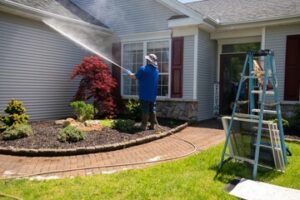A sudden roof leak or storm-damaged shingles are scary and stressful. Understanding when immediate intervention is required can help you manage the situation effectively and safely while awaiting professional repairs.

Taking immediate action can prevent further damage and save you money. Temporary measures include placing buckets under leaks, moving valuables away from the water source, and utilizing fans to dry wet areas. Contact Emergency Roof Repair Las Vegas NV for professional help.
As a homeowner, it’s your responsibility to maintain your roof to protect your home from the elements. One of the most common signs that your roof is in need of repair or replacement is loose or missing shingles. Loose shingles are particularly vulnerable to high winds and other severe weather conditions, which can cause further damage to your roof. In the long run, this can lead to leaks and other costly issues that require professional repairs.
If you notice that some of your shingles are loose or have been torn off during a recent storm, it’s important to act quickly. The longer you wait, the more extensive the damage will be and the more expensive it will be to fix.
To assess the extent of the damage, carefully inspect your shingles from the ground using a pair of binoculars. If it’s safe to do so, climb onto your roof and take care to use a ladder that is secure and sturdy. It’s also recommended to wear proper safety equipment, including a harness and heavy-duty gloves.
Inspect each shingle individually to see if any are loose or have been completely removed. If you find any, first remove any debris from the area and then apply roofing cement or adhesive under the shingle that’s been lifted. Press it down firmly and secure the edges to the adjacent shingles to ensure it’s fully attached.
For shingles that are completely missing, you’ll want to cover the affected area with a tarp until a professional can repair it. Before you do, make sure the tarp is large enough to extend several feet beyond the damaged area on all sides. Then, anchor it down with ropes or bungee cords to prevent it from blowing away during a storm. Make sure to check the tarp regularly to see if any water is leaking through the holes.
Small Holes or Cracks
Small holes or cracks in your roof are not a sign of structural issues, but they can allow moisture, pests, and sunlight into your home. A visual inspection can help you determine if the holes are a result of aging, debris, or other problems. Inspecting both sides of the hole and taking notes will also help you understand the extent of the problem when consulting with a professional.
You should also pay attention to the areas around chimneys and vents, as these are common spots for holes to form. Periodic inspections of these areas will keep them from deteriorating and will save you money in the long run.
During your inspection, you should also pay close attention to any areas where you see daylight streaming in during the day. Light streams can be signs of severe cracks or missing shingles that need to be addressed quickly.
If you have a tile roof, small cracks are typically caused by normal wear and tear, and they can be repaired with a roofing patch or sealant. For rubber roofs, it is best to consult a professional to ensure that the cracks are sealed properly to prevent water leaks.
The first step in fixing a leak is to identify where the leak is coming from, and this usually requires a thorough attic inspection of the rafters and joists. This will often lead to the location of the leak source, and a professional will be able to repair the issue for you.
A leak in the ceiling can cause significant damage to the interior of your home, and it should be addressed immediately. Depending on the severity of the leak, you may need to install a temporary patch to stop further water damage. For this, you should use a heavy duty tarp that is waterproof and can withstand varying weather conditions. You should also be sure to choose a tarp that is large enough to completely cover the damaged area, and leave at least two inches of overlap on all sides of the patch. You should also round the corners of the tarp to avoid sharp edges that could catch snow or ice and cause further damage.
Leaking Roofs
The roof over our heads is something that is often taken for granted – until there’s a leak. When water seeps into the house, it can cause damage to ceilings, drywall, insulation and electrical wiring. In many cases, a leaking roof can also lead to mold, mildew and structural issues.
One of the most serious problems a homeowner can face is a leaking roof, and it’s one that can be very difficult to locate. If you notice that there are water stains on the ceiling or walls, it’s important to take action quickly and contact a professional for assistance.
Before you call a roofing company, make sure to do your own inspection to determine the source of the leak. Start by walking around the house and looking for any areas where there are water stains or drips on the ceiling or wall. This is the most likely area where the leak is coming from. Then, move upwards on the roof, paying special attention to any areas where flashing is used – such as vents, chimneys and roof valleys. The flashing is the thin piece of metal that seals the gap between the shingle and the wall, and if it’s cracked or missing, it can allow water to enter the home.
When you find the location of the leak, have a helper stand inside the house with a garden hose. Have the helper spray a section of the roof in the general area where the leak is appearing inside the house, and then watch for any signs of moisture or discoloration on the shingles and underlying roof paper. If the leaking spot appears, mark it so that your roofer can repair the problem quickly.
While a leaky roof is certainly an emergency, it’s possible to prevent these kinds of problems by performing regular inspections and making minor repairs as needed. By taking the time to perform these tasks, you can extend the lifespan of your roof and keep it in good condition for years to come. It’s also a good idea to clear debris from your roof regularly, as this can help prevent standing water that can lead to leaks and other damage.
Water Damage
The roof is a crucial component of your home that shields you from the elements, offers insulation, and contributes to the aesthetic of your property. However, your roof is not invincible and it can be damaged by storms, hail, or internal issues like severe leaks or mold growth. Recognizing these key indicators and acting quickly can prevent further damage and limit your insurance repair bill.
Emergency roofing repairs typically involve temporary solutions that stabilize your roof and protect your home from further damage until permanent repairs are made. These measures include covering exposed areas with tarps, reinforcing torn shingles with patches, and removing and drying water-damaged materials. These steps can minimize further damage, reduce the likelihood of mold and other fungi, and improve indoor air quality.
A leaking roof can lead to extensive damage in a short period of time. Even a small leak can seep into support beams, which can weaken and compromise the structural integrity of your home. It can also seep into walls and ceilings, causing rotting, staining, or other problems. Damp conditions can also promote the growth of harmful molds, which can threaten the health and safety of your family.
In the case of a sudden loss of shingles, a sudden deterioration in the quality of your roof, or a structural problem with your roof, it may be necessary to conduct emergency repairs to avoid further damage. A professional roofer can assess your roof to determine the severity of any damage and recommend the best course of action.
Identifying roof issues before they become emergencies can help you save money, avoid costly damage, and maintain the value of your home. It’s important to know the warning signs to look out for, and taking proactive measures can ensure that minor repairs don’t become significant disasters.
Start by conducting a visual inspection of your roof from the ground. Take notes and photographs, which can be helpful when filing an insurance claim or explaining the situation to a roofing contractor. If safe to do so, cover up furniture and other valuables with tarps or plastic covers, move items that can be easily moved, and use fans and dehumidifiers to dry wet areas.



